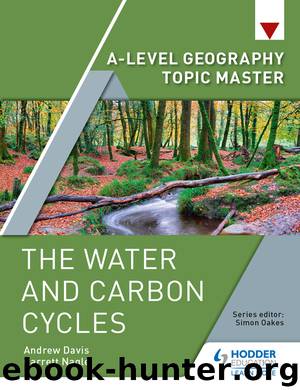A-Level Geography Topic Master: The Water and Carbon Cycles by Andrew Davis & Garrett Nagle

Author:Andrew Davis & Garrett Nagle [Davis, Andrew; Nagle, Garrett]
Language: eng
Format: epub
Publisher: Hodder Education
Published: 2018-04-14T16:00:00+00:00
and
Although there were some differences between the top-down and bottom-up approaches, eddy covariance estimates for both GPP and Re are relatively closely matched within the biometric data (uncertainties within biometric measurements taken into account), suggesting that either technique can be used with confidence to estimate carbon budgets.
The Wytham Woods site was estimated to be a substantial carbon sink of 1.2 MgC ha−1 yr−1 between May 2007 and April 2009. Over the two years, GPP remained similar for equivalent months in different years whereas NEP varied: difference in seasonal NEP was predominantly thought to be caused by changes in ecosystem respiration.
GPP and Re values were generally higher than other broad-leaved temperate deciduous woodlands, possibly due to the influence of the UK’s maritime climate, or the specific species composition of the site.
Figure 4.10 shows a summary of data compartmentalised and covering specific aspects of forest ecology, using results from both bottom-up and top-down approaches. This figure gives a clear indication of the complexity and magnitude of carbon fluxes at the local scale. Units for Figure 4.10 are MgC ha–1 yr–1.
Figure 4.10 The carbon cycle of Wytham Woods, constructed from the measured components. B indicates measurements taken from biometric (bottom-up) data and T indicates data taken from the tower (eddy-covariance/top-down); R indicates respiration, with RECO B = respiration recorded from biometric data, RECO T = respiration recorded from tower, RAUTO = autotrophic respiration, RHet = heterotrophic respiration; NPPAg indicates above-ground, NPPBg below-ground NPP, and NPPTotal the combined NPP from both above and below-ground; CWD = coarse woody debris; NPPLITTER = canopy litter-fall (leaves, flowers, fruit) and FLITTER = the fraction entering the soil (rather than respired in the litter layer); MAG = the mean annual production of above-ground CWD over a three-year period; RRRHIZ, RMYC, and RSOM are respiration from roots and the rhizosphere (a region of the soil that is affected by secretions from root and associated soil microorganisms), mycorrhizas (fungi that have a symbiotic relationship with tree roots) and soil organic matter decomposition, respectively, which sum to total soil respiration, RSOIL
Download
This site does not store any files on its server. We only index and link to content provided by other sites. Please contact the content providers to delete copyright contents if any and email us, we'll remove relevant links or contents immediately.
Talking to Strangers by Malcolm Gladwell(13293)
The Compound Effect by Darren Hardy(8873)
Tools of Titans by Timothy Ferriss(8306)
Wonder by R. J. Palacio(8060)
The Lover by Duras Marguerite(7859)
A Court of Wings and Ruin by Sarah J. Maas(7733)
The Circle by Dave Eggers(7066)
Deep Work by Cal Newport(6969)
Kaplan MCAT General Chemistry Review by Kaplan(6903)
To All the Boys I've Loved Before by Jenny Han(5810)
Wiseguy by Nicholas Pileggi(5711)
The Body: A Guide for Occupants by Bill Bryson(5031)
Eat That Frog! by Brian Tracy(4484)
1,001 ASVAB Practice Questions For Dummies by Powers Rod(4472)
Cracking the GRE Premium Edition with 6 Practice Tests, 2015 (Graduate School Test Preparation) by Princeton Review(4250)
Pre-Suasion: A Revolutionary Way to Influence and Persuade by Robert Cialdini(4186)
Barron's AP Biology by Goldberg M.S. Deborah T(4124)
ACT Math For Dummies by Zegarelli Mark(4024)
Alive: The Story of the Andes Survivors by Piers Paul Read(3998)
